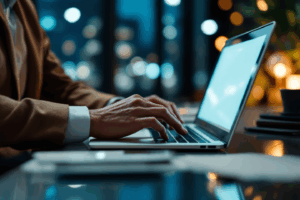
English Grammar for Business
"Let's Learn, Explore, and Connect to the World"

Mechanics and Punctuation for Emails
- Jenelie Hijosa
- English Grammar for Business

Introduction

In the fast-paced world of business, where emails serve as the linchpin of professional communication, the importance of correct mechanics and punctuation cannot be overstated. At first glance, these might seem like mere embellishments to the untrained eye. However, they hold the power to not only convey your message effectively but also to reflect your professional image. In an era where digital correspondence often serves as the first, and sometimes the only, point of contact between professionals, a well-crafted email stands out, fostering positive perceptions and facilitating clear, misunderstanding-free communication.
Correct mechanics and punctuation in business emails do more than just prevent misinterpretations; they enhance the reader’s experience by providing clarity, nuance, and the intended tone of the message. For instance, the difference between “Let’s go, Grandma!” and “Let’s go Grandma!” is stark, underscoring how crucial punctuation can be in conveying the correct message. In a business context, such distinctions can clearly differentiate between a successful collaboration and a potential professional faux pas.
 Moreover, the role of effective communication extends beyond the individual, influencing the broader professional setting. It is the foundation upon which relationships are built and maintained. In business environments, where time is a valuable commodity, the ability to communicate efficiently and clearly directly impacts productivity and operational success. Emails that are concise, well-structured, and free from errors are more likely to be read and responded to promptly, facilitating smoother workflows and quicker decision-making processes.
Moreover, the role of effective communication extends beyond the individual, influencing the broader professional setting. It is the foundation upon which relationships are built and maintained. In business environments, where time is a valuable commodity, the ability to communicate efficiently and clearly directly impacts productivity and operational success. Emails that are concise, well-structured, and free from errors are more likely to be read and responded to promptly, facilitating smoother workflows and quicker decision-making processes.
Thus, understanding and applying the principles of mechanics and punctuation in email communication is not just about adhering to grammatical norms but about harnessing these tools to enhance professional interactions. As we delve deeper into the mechanics and punctuation for business emails, it becomes evident that mastering these aspects is integral to professional success and effective business communication.
Fundamental Principles of Writing Business Emails
 In the realm of business communication, emails are a primary tool for exchanging information, proposals, updates, and even casual professional greetings. To harness the full potential of this tool, it is imperative to grasp and apply three fundamental principles: clarity and conciseness, tone and formality, and audience awareness. These principles are not just guidelines but the backbone of effective email writing, ensuring that the message not only reaches the recipient but also achieves its intended effect.
In the realm of business communication, emails are a primary tool for exchanging information, proposals, updates, and even casual professional greetings. To harness the full potential of this tool, it is imperative to grasp and apply three fundamental principles: clarity and conciseness, tone and formality, and audience awareness. These principles are not just guidelines but the backbone of effective email writing, ensuring that the message not only reaches the recipient but also achieves its intended effect.
Clarity and Conciseness
 The cornerstone of any effective business email is its ability to convey a message clearly and concisely. In a business setting, time is of the essence. Recipients often skim through emails, looking for pertinent information. Therefore, getting to the point quickly without sacrificing clarity is crucial. This requires a disciplined approach to writing, focusing on straightforward language and avoiding unnecessary jargon or verbosity. Clarity is further enhanced by structuring the email logically, with a clear introduction, body, and conclusion, ensuring the recipient can easily follow the message’s progression and grasp its essence promptly.
The cornerstone of any effective business email is its ability to convey a message clearly and concisely. In a business setting, time is of the essence. Recipients often skim through emails, looking for pertinent information. Therefore, getting to the point quickly without sacrificing clarity is crucial. This requires a disciplined approach to writing, focusing on straightforward language and avoiding unnecessary jargon or verbosity. Clarity is further enhanced by structuring the email logically, with a clear introduction, body, and conclusion, ensuring the recipient can easily follow the message’s progression and grasp its essence promptly.
Tone and Formality
 The tone of a business email should strike a balance between professionalism and approachability. It’s a reflection of your company’s culture and your professional demeanor. While the default tone for most business emails is formal and polite, there is room for slight adjustments based on the relationship with the recipient and the email’s context. For instance, an email to a long-standing client with whom you have a friendly relationship may be less formal than one to a new prospect. However, maintaining a level of formality is crucial to ensure the message is taken seriously. This is where punctuation and mechanics play a pivotal role; they help convey the intended tone, whether assertive, inquisitive, or something else entirely.
The tone of a business email should strike a balance between professionalism and approachability. It’s a reflection of your company’s culture and your professional demeanor. While the default tone for most business emails is formal and polite, there is room for slight adjustments based on the relationship with the recipient and the email’s context. For instance, an email to a long-standing client with whom you have a friendly relationship may be less formal than one to a new prospect. However, maintaining a level of formality is crucial to ensure the message is taken seriously. This is where punctuation and mechanics play a pivotal role; they help convey the intended tone, whether assertive, inquisitive, or something else entirely.
Audience Awareness
 To understand your audience is crucial in tailoring your message to their expectations and needs. Audience awareness encompasses several dimensions, including the recipient’s position within their organization, their familiarity with the subject matter, and their cultural background. These factors influence not only the content of your message but also your language choice and level of detail. For instance, technical jargon may be appropriate when writing to a specialist in your field but could confuse someone from a non-technical background. Similarly, cultural sensitivity is vital, especially in global business environments, where what’s considered polite or informal can vary widely. Being aware of these nuances and adjusting your email accordingly can significantly enhance communication efficacy and foster positive professional relationships.
To understand your audience is crucial in tailoring your message to their expectations and needs. Audience awareness encompasses several dimensions, including the recipient’s position within their organization, their familiarity with the subject matter, and their cultural background. These factors influence not only the content of your message but also your language choice and level of detail. For instance, technical jargon may be appropriate when writing to a specialist in your field but could confuse someone from a non-technical background. Similarly, cultural sensitivity is vital, especially in global business environments, where what’s considered polite or informal can vary widely. Being aware of these nuances and adjusting your email accordingly can significantly enhance communication efficacy and foster positive professional relationships.
In the end, the principles of clarity and conciseness, tone and formality, and audience awareness are not standalone tips but interlinked strategies that, when executed well, elevate the quality and effectiveness of business emails. These foundational elements ensure that your emails not only convey the intended message but also build and maintain professional rapport, facilitate smooth business operations, and reflect positively on your professional image.
Mechanics in Business Emails
 The mechanics of writing—encompassing sentence structure, word choice, and verb tense consistency—are essential components of effective business emails. These elements work in harmony to ensure that emails are not only readable and coherent but also convey professionalism and precision. In the context of business communications, where the aim is to share information efficiently and foster positive professional relationships, the significance of these mechanics cannot be understated.
The mechanics of writing—encompassing sentence structure, word choice, and verb tense consistency—are essential components of effective business emails. These elements work in harmony to ensure that emails are not only readable and coherent but also convey professionalism and precision. In the context of business communications, where the aim is to share information efficiently and foster positive professional relationships, the significance of these mechanics cannot be understated.
Sentence Structure: Ensuring Readability and Coherence
 A well-structured sentence is the bedrock of clear communication. In business emails, the goal is to convey complex ideas in a way that is easy for the reader to digest. This involves crafting sentences that are neither too long nor too short but are just right to maintain the reader’s attention and ensure comprehension. Long, run-on sentences can be confusing and may obscure the main point, while overly short sentences can make an email feel choppy and disjointed. Balancing sentence length and structure enhances readability and helps maintain a flow that guides the reader through the message seamlessly.
A well-structured sentence is the bedrock of clear communication. In business emails, the goal is to convey complex ideas in a way that is easy for the reader to digest. This involves crafting sentences that are neither too long nor too short but are just right to maintain the reader’s attention and ensure comprehension. Long, run-on sentences can be confusing and may obscure the main point, while overly short sentences can make an email feel choppy and disjointed. Balancing sentence length and structure enhances readability and helps maintain a flow that guides the reader through the message seamlessly.
Effective sentence structure also includes the use of transitions and signposting language to indicate relationships between ideas, whether they are additive, contrastive, or causal. This coherence in communication ensures that the reader can follow the logical flow of ideas without getting lost or misunderstanding the message’s intent.
Word Choice: Selecting Precise Vocabulary for Clear Communication
 The words we choose in our emails can significantly impact how our message is received. In a business context, selecting precise vocabulary is crucial for clear communication. The right word can convey a message succinctly and effectively, while the wrong word can lead to confusion or misinterpretation. Moreover, the use of specific, industry-relevant terminology can establish credibility and demonstrate expertise, provided it is used appropriately and the audience is familiar with the terms.
The words we choose in our emails can significantly impact how our message is received. In a business context, selecting precise vocabulary is crucial for clear communication. The right word can convey a message succinctly and effectively, while the wrong word can lead to confusion or misinterpretation. Moreover, the use of specific, industry-relevant terminology can establish credibility and demonstrate expertise, provided it is used appropriately and the audience is familiar with the terms.
However, it’s also important to avoid unnecessary jargon and complex language that could alienate the reader. The balance lies in using language that is both accurate and accessible, ensuring the message is understood by the recipient, regardless of their level of familiarity with the subject matter.
Verb Tense Consistency: Maintaining a Professional Tone and Clarity

Verb tense consistency is another critical aspect of the mechanics in business emails. Maintaining a consistent tense throughout an email helps preserve a professional tone and clarity. Shifting tenses can confuse the reader and make the email seem disjointed, detracting from the message’s effectiveness. For instance, when discussing a project’s current status, sticking to the present tense provides clarity and immediacy. Similarly, when outlining a sequence of past events or forecasting future activities, consistent use of the past or future tense, respectively, is essential for coherence.
Consistent verb tense also contributes to a professional tone by demonstrating attention to detail and mastery of language, reinforcing the sender’s credibility. In turn, this fosters trust and respect in professional relationships, as clear and consistent communication is often seen as a reflection of one’s professional standards and capabilities.
The mechanics of business emails—sentence structure, word choice, and verb tense consistency—are foundational to crafting messages that are readable, coherent, and professional. These elements ensure that emails not only convey information efficiently but also reflect positively on the sender’s professionalism and attention to detail. As we navigate the intricacies of business communication, mastering these mechanics becomes indispensable for anyone looking to enhance their professional correspondence.
Punctuation in Business Emails
 Punctuation serves as the silent guide in written communication, subtly influencing the flow, clarity, and tone of the text. In business emails, where the goal is to communicate effectively and professionally, the correct use of punctuation marks becomes a critical tool. It can transform a jumbled mess of words into a coherent message, emphasize key points, and convey the intended emotion or level of formality. Let’s delve into the specifics of how certain punctuation marks—commas, periods, semicolons, question marks, exclamation points, apostrophes, and quotation marks—play pivotal roles in the crafting of business emails.
Punctuation serves as the silent guide in written communication, subtly influencing the flow, clarity, and tone of the text. In business emails, where the goal is to communicate effectively and professionally, the correct use of punctuation marks becomes a critical tool. It can transform a jumbled mess of words into a coherent message, emphasize key points, and convey the intended emotion or level of formality. Let’s delve into the specifics of how certain punctuation marks—commas, periods, semicolons, question marks, exclamation points, apostrophes, and quotation marks—play pivotal roles in the crafting of business emails.
Commas, Periods, and Semicolons: Crafting Complex, Yet Clear Sentences
The comma, period, and semicolon are the workhorses of punctuation, each playing a unique role in enhancing readability and structure. The purpose of commas are to separate elements in a series, to set off introductory elements, and to distinguish clauses. They help the reader pause appropriately, ensuring that the sentence is easy to follow. For example, in listing a series of items or actions in a business email, commas make the sequence clear without overwhelming the reader.
Periods mark the end of sentences, a straightforward yet crucial role. They signify a full stop, a moment for the reader to pause and digest what has been said before moving on to the next point. The correct use of periods prevents run-on sentences, making the email easier to understand.
Semicolons are often used to link independent clauses without using conjunctions, or to separate items in a list when those items contain commas. They allow for the crafting of complex sentences that are still clear and easy to read. For instance, in explaining a complex process or series of events, semicolons can help maintain the flow of information without confusing the reader.
Question Marks and Exclamation Points: Conveying Tone Appropriately
Question marks and exclamation points are powerful tools for conveying tone in business emails. A question mark indicates an inquiry or a request for information, inviting a response. It’s crucial in emails where clarity about the nature of the request or question is paramount.
Exclamation points, on the other hand, should be used sparingly in business communications. While they can convey excitement or urgency, overuse can make an email seem unprofessional or overly emotional. When used judiciously, an exclamation point can highlight a significant achievement or express genuine enthusiasm, adding a personal touch to professional correspondence.
Apostrophes and Quotation Marks: Demonstrating Attention to Detail
Apostrophes are most commonly used to indicate possession or to form contractions. Their correct use shows attention to detail and mastery of the nuances of English grammar, contributing to the professional tone of an email.
One of the uses of quotation marks are to denote direct speech, quotations, or titles of certain works. In business emails, they can be used to highlight feedback, specify terminology, or cite sources. The accurate use of quotation marks ensures that the intended message is clear and that any referenced words or phrases are correctly attributed, reinforcing the credibility of the email.
Understanding and applying the correct use of punctuation marks in business emails is not just about adhering to grammatical rules. It’s about crafting messages that are clear, professional, and reflective of the sender’s attention to detail. This mastery of punctuation enhances the effectiveness of communication to ensure that message is conveyed accurately and received positively.
Common Mistakes to Avoid in Business Emails
 In the pursuit of professional excellence, paying attention to the common mistakes in business emails is as crucial as understanding the best practices. Certain errors are frequently encountered in the digital workplace, and avoiding these can significantly enhance the effectiveness and professionalism of your communication. Here are three common pitfalls to be wary of: the overuse of jargon and complex vocabulary, neglecting proofreading, and the misuse of punctuation marks.
In the pursuit of professional excellence, paying attention to the common mistakes in business emails is as crucial as understanding the best practices. Certain errors are frequently encountered in the digital workplace, and avoiding these can significantly enhance the effectiveness and professionalism of your communication. Here are three common pitfalls to be wary of: the overuse of jargon and complex vocabulary, neglecting proofreading, and the misuse of punctuation marks.
Overuse of Jargon and Complex Vocabulary
While specialized terminology can be necessary and useful in certain contexts, its overuse, especially when communicating with a non-specialist audience, can lead to confusion and misinterpretation. Complex vocabulary and industry-specific jargon can alienate readers and obscure your message’s meaning. The goal of business communication should be to convey your message as clearly and accessible as possible. Simplifying your language does not diminish your expertise; rather, it demonstrates your ability to communicate effectively with a broad audience. Always consider the recipient’s perspective and adjust your language accordingly to ensure your message is understood.
Neglecting Proofreading: The Importance of Reviewing for Punctuation and Grammar Errors
 The fast-paced nature of the business world often leads to hurriedly composed emails sent without a thorough review. However, emails riddled with punctuation and grammar errors not only undermine the message’s clarity but also reflect poorly on the sender’s professionalism. Taking the time to proofread your emails before sending them is a simple yet effective practice that can prevent misunderstandings and convey a positive, professional image. Tools such as spell checkers and grammar-checking software can assist in this process, but a final, careful read-through is irreplaceable for catching overlooked errors or awkward phrasings.
The fast-paced nature of the business world often leads to hurriedly composed emails sent without a thorough review. However, emails riddled with punctuation and grammar errors not only undermine the message’s clarity but also reflect poorly on the sender’s professionalism. Taking the time to proofread your emails before sending them is a simple yet effective practice that can prevent misunderstandings and convey a positive, professional image. Tools such as spell checkers and grammar-checking software can assist in this process, but a final, careful read-through is irreplaceable for catching overlooked errors or awkward phrasings.
Misusing Punctuation Marks: A Look at Common Errors and How to Avoid Them
Punctuation is the scaffolding that supports clear written communication, yet it is often misused. Common errors include the overuse of exclamation points, which can make an email seem unprofessional; incorrect use of commas, leading to confusing sentences; and the misuse of semicolons, which can complicate rather than clarify the message. Understanding the basic rules of punctuation and applying them judiciously can vastly improve the readability and professionalism of your emails. When in doubt, opt for simpler sentence constructions that are less prone to punctuation errors.
By avoiding the overuse of jargon, committing to thorough proofreading, and using punctuation correctly, you can significantly enhance the clarity, professionalism, and effectiveness of your business emails. These practices not only improve your communication but also reinforce your professional credibility.
Practical Tips for Mastering Mechanics and Punctuation
Navigating the complexities of English mechanics and punctuation can be challenging, but with the right strategies, it becomes an attainable goal. Improving your business email communication is not just about understanding the rules but also about knowing how to apply them effectively. Here are three practical tips to guide you on this journey:
Utilizing Online Tools and Resources for Grammar and Punctuation Checks

In the digital age, numerous tools and resources are available to assist with grammar and punctuation checks. Software like Grammarly, Hemingway Editor, and Microsoft Word’s built-in grammar checker can be invaluable for identifying and correcting errors in real-time. These tools not only highlight mistakes but also explain why something is considered an error, providing an opportunity for learning and improvement. However, it’s essential to use these tools as aids rather than relying on them completely. Developing an understanding of grammar and punctuation rules will help you make informed decisions about your writing.
The Importance of Continuous Learning and Practice

Mastering the mechanics of writing and punctuation is an ongoing process. The English language is rich and complex, and its conventions can be nuanced. Engaging with resources such as writing guides, online courses, and workshops can deepen your understanding of effective communication. Regular practice is also equally important. The more you write and apply what you’ve learned, the more natural these rules will become in your writing process.
Seeking Feedback and Learning from Mistakes

One of the most effective ways to improve your writing is by seeking feedback from peers, mentors, or professional editors. Constructive criticism can shed light on areas for improvement that you might not see yourself. Additionally, embracing your mistakes as learning opportunities is crucial. Analyzing errors in your writing helps prevent them in the future and strengthens your overall communication skills.
Mastering the mechanics and punctuation of business emails is a multifaceted process that involves leveraging digital tools, committing to continuous learning, and actively seeking feedback. By incorporating these practical tips into your writing practice, you can improve your communication ability clearly and professionally, furthering your career and business goals.
Conclusion
 Throughout this guide, we’ve delved into the intricate world of mechanics and punctuation, highlighting their pivotal role in crafting clear, concise, and professional business emails. From the foundational principles of writing—emphasizing clarity, tone, and audience awareness—to the detailed exploration of sentence structure, word choice, and verb tense consistency, we’ve seen how each element contributes to effective communication. The correct usage of punctuation marks which include commas, periods, semicolons, and more, further refines our messages, ensuring they convey the intended tone and detail.
Throughout this guide, we’ve delved into the intricate world of mechanics and punctuation, highlighting their pivotal role in crafting clear, concise, and professional business emails. From the foundational principles of writing—emphasizing clarity, tone, and audience awareness—to the detailed exploration of sentence structure, word choice, and verb tense consistency, we’ve seen how each element contributes to effective communication. The correct usage of punctuation marks which include commas, periods, semicolons, and more, further refines our messages, ensuring they convey the intended tone and detail.
Avoiding common pitfalls such as the overuse of jargon, neglecting proofreading, and misusing punctuation is crucial for maintaining professionalism. We also discussed practical strategies for improvement, including leveraging online tools, embracing continuous learning, and seeking feedback, which collectively enhance our writing skills.
 As we conclude, remember that prioritizing the mechanics and punctuation in your business communications is not merely about following rules—it’s about making a lasting impression, fostering clear understanding, and achieving professional success. Let these principles guide your writing, and watch as your professional communications transform, leading to stronger relationships, clearer exchanges, and a heightened sense of credibility in your professional endeavors.
As we conclude, remember that prioritizing the mechanics and punctuation in your business communications is not merely about following rules—it’s about making a lasting impression, fostering clear understanding, and achieving professional success. Let these principles guide your writing, and watch as your professional communications transform, leading to stronger relationships, clearer exchanges, and a heightened sense of credibility in your professional endeavors.
References
- Mcaleer, D. (2023, June 16). Seven key components of a successful digital marketing strategy. Onimod Global. https://www.onimodglobal.com/seven-key-components-of-a-successful-digital-marketing-strategy/
- Hurmanblirrikkufhk.netlify.app. (n.d.). How to write a quote in a quote. Retrieved from https://hurmanblirrikkufhk.netlify.app/67408/41162.html
- Iran Press News. (2023, August 13). Mastering the art of emailing Andrew Tate: A guide for effective communication. Iran Press News. https://iranpressnews.net/entrepreneurs/andrew-tate/mastering-the-art-of-emailing-andrew-tate-a-guide-for-effective-communication/
- English Teacher. (2023, August 10). Capitalizing after a semicolon: The definitive guide. Punctuation Marks. https://punctuationmarks.org/do-you-capitalize-after-a-semicolon/
Latest Blogs

Past Simple Tense 2
English Blogs “Let’s Learn, Explore, and Connect to the World” Past Simple Tense 2 II. Understanding the Past Simple Tense The past simple tense is

Future (Be going to) 5
English Blogs “Let’s Learn, Explore, and Connect to the World” Future (Be going to) 5 V. Practical Tips for Usage and Common Mistakes in ‘Be
Reading comprehension quiz
Check out our books and more!

Comic Collections : A Compilation of Daily Professional and Casual Conversations (Book 2)
Master conversation with ‘Comic Collections’ (Book 2) by Cassia North. A fun, insightful guide to professional and casual communication, packed with engaging comics and practical tips for every interaction!
Check out our Blogs!
Read our everyday blogs and gain new knowledge, skills, and inspiration to support your learning journey here in SEKAEL.


Learn through Common English Errors Blogs by recognizing and correcting everyday grammar and usage mistakes.







 In today’s digitally driven business landscape, email stands out as a cornerstone of corporate communication. Its efficiency, speed, and broad reach make it a preferred medium for exchanging information, ideas, and decisions across the globe. However, the effectiveness of an email is significantly influenced by two fundamental aspects of writing: sentence structure and clarity. These elements are not merely ornamental; they are crucial in ensuring your message is understood exactly as intended, avoiding misinterpretations that can lead to costly mistakes or missed opportunities.
In today’s digitally driven business landscape, email stands out as a cornerstone of corporate communication. Its efficiency, speed, and broad reach make it a preferred medium for exchanging information, ideas, and decisions across the globe. However, the effectiveness of an email is significantly influenced by two fundamental aspects of writing: sentence structure and clarity. These elements are not merely ornamental; they are crucial in ensuring your message is understood exactly as intended, avoiding misinterpretations that can lead to costly mistakes or missed opportunities. The purpose of this blog is to delve deep into the art and science of sentence structure and clarity, specifically tailored for business emails. We’ll start by exploring the basic components of sentences and the types of structures that can be used to enhance readability and engagement. Following this, we’ll tackle the common pitfalls that obscure clarity and present strategies to avoid them. Useful techniques and real-life examples will guide you on how to apply these principles to your daily email communications. By the end of this post, you’ll have what you need when it comes to the knowledge and tools to write emails that are not only read but also respected for their professionalism and precision.
The purpose of this blog is to delve deep into the art and science of sentence structure and clarity, specifically tailored for business emails. We’ll start by exploring the basic components of sentences and the types of structures that can be used to enhance readability and engagement. Following this, we’ll tackle the common pitfalls that obscure clarity and present strategies to avoid them. Useful techniques and real-life examples will guide you on how to apply these principles to your daily email communications. By the end of this post, you’ll have what you need when it comes to the knowledge and tools to write emails that are not only read but also respected for their professionalism and precision.



 Utilizing a variety of sentence structures is vital for keeping the reader’s attention and ensuring the readability of your emails. Monotonous sentence patterns can make your emails dull and harder to follow, while a mix of simple, compound, complex, and compound-complex sentences adds rhythm and dynamics to your writing. This variation helps in highlighting important points, creating suspense, or adding details subtly without overwhelming the reader.
Utilizing a variety of sentence structures is vital for keeping the reader’s attention and ensuring the readability of your emails. Monotonous sentence patterns can make your emails dull and harder to follow, while a mix of simple, compound, complex, and compound-complex sentences adds rhythm and dynamics to your writing. This variation helps in highlighting important points, creating suspense, or adding details subtly without overwhelming the reader. Clarity in email communication is the bridge that connects your thoughts to the understanding of your recipients. It’s about making your message understandable at first glance, which is crucial in the fast-paced world of business where time is a precious commodity. Clear emails reduce the need for follow-up questions, decrease the likelihood of misunderstandings, and facilitate efficient decision-making. In essence, clarity helps in achieving your email’s objective more effectively, whether it’s securing a deal, providing instructions, or making a request.
Clarity in email communication is the bridge that connects your thoughts to the understanding of your recipients. It’s about making your message understandable at first glance, which is crucial in the fast-paced world of business where time is a precious commodity. Clear emails reduce the need for follow-up questions, decrease the likelihood of misunderstandings, and facilitate efficient decision-making. In essence, clarity helps in achieving your email’s objective more effectively, whether it’s securing a deal, providing instructions, or making a request.


 By integrating these practical tips into your email writing, you can significantly improve the effectiveness of your sentences. This not only aids in conveying your message with clarity and precision but also enhances the reader’s engagement and comprehension. Remember, the goal is to make your emails not just readable, but memorable and impactful.
By integrating these practical tips into your email writing, you can significantly improve the effectiveness of your sentences. This not only aids in conveying your message with clarity and precision but also enhances the reader’s engagement and comprehension. Remember, the goal is to make your emails not just readable, but memorable and impactful. Organizing information logically is paramount in business emails. It ensures that your message is coherent and that your key points are easy to find and understand. You can start by outlining the main points you want to communicate, then organize these points in a logical order. This could mean arranging them by priority, chronologically, or according to their relevance to the recipient. You can use headings, bullet points, or numbered lists to structure your content to make it easier for the reader to scan and grasp the essential information.
Organizing information logically is paramount in business emails. It ensures that your message is coherent and that your key points are easy to find and understand. You can start by outlining the main points you want to communicate, then organize these points in a logical order. This could mean arranging them by priority, chronologically, or according to their relevance to the recipient. You can use headings, bullet points, or numbered lists to structure your content to make it easier for the reader to scan and grasp the essential information.




 We began by understanding the importance of sentence structure and how the basic components of sentences—subject, verb, and object—combine to form clear and impactful messages. We explored the different types of sentences: simple, compound, complex, and compound-complex, and emphasized the significance of varying sentence structures to enhance readability and engagement in our emails.
We began by understanding the importance of sentence structure and how the basic components of sentences—subject, verb, and object—combine to form clear and impactful messages. We explored the different types of sentences: simple, compound, complex, and compound-complex, and emphasized the significance of varying sentence structures to enhance readability and engagement in our emails. Practical tips for crafting effective sentences shed light on the use of active vs. passive voice, the importance of punctuation for clarity, and how connectors and transitions can guide the reader smoothly through our message.
Practical tips for crafting effective sentences shed light on the use of active vs. passive voice, the importance of punctuation for clarity, and how connectors and transitions can guide the reader smoothly through our message. Mastering the art of writing clear and structured emails is a journey of continuous improvement. Each email you write offers an opportunity to apply these principles, refine your skills, and enhance your ability to communicate effectively. Practice is key. Challenge yourself to review and revise your emails with the tips and techniques discussed, and observe the impact on your communication and the responses from your recipients.
Mastering the art of writing clear and structured emails is a journey of continuous improvement. Each email you write offers an opportunity to apply these principles, refine your skills, and enhance your ability to communicate effectively. Practice is key. Challenge yourself to review and revise your emails with the tips and techniques discussed, and observe the impact on your communication and the responses from your recipients.







 In the active world of digital marketing, influencer marketing has emerged as a powerhouse strategy, transforming the way brands connect with their audience. At its core, influencer marketing is about leveraging the reach and credibility of individuals who hold sway over a significant following on social media platforms, particularly Instagram. This strategy harnesses the power of personal recommendation, which has been a cornerstone of consumer trust for generations, adapted for the digital age.
In the active world of digital marketing, influencer marketing has emerged as a powerhouse strategy, transforming the way brands connect with their audience. At its core, influencer marketing is about leveraging the reach and credibility of individuals who hold sway over a significant following on social media platforms, particularly Instagram. This strategy harnesses the power of personal recommendation, which has been a cornerstone of consumer trust for generations, adapted for the digital age. Instagram, with over a billion active users, serves as the perfect stage for this form of marketing. Its visually driven platform allows for vivid storytelling and personal engagement, making it an ideal space for influencers to connect with their audience and showcase brand collaborations. The significance of Instagram in influencer marketing cannot be overstated; it’s where visual content thrives, where trends are set, and where brands can see substantial engagement and growth through strategic partnerships.
Instagram, with over a billion active users, serves as the perfect stage for this form of marketing. Its visually driven platform allows for vivid storytelling and personal engagement, making it an ideal space for influencers to connect with their audience and showcase brand collaborations. The significance of Instagram in influencer marketing cannot be overstated; it’s where visual content thrives, where trends are set, and where brands can see substantial engagement and growth through strategic partnerships. In today’s digital era, Instagram has risen not just as a social media platform but as a pivotal force in digital marketing. Its inception revolutionized the way brands approach marketing, moving beyond traditional mediums to embrace a more visual and interactive form of storytelling. This transformation is largely driven by Instagram’s inherent ability to facilitate a visual narrative, making it an invaluable tool for brands to connect with their audience on a personal and emotional level.
In today’s digital era, Instagram has risen not just as a social media platform but as a pivotal force in digital marketing. Its inception revolutionized the way brands approach marketing, moving beyond traditional mediums to embrace a more visual and interactive form of storytelling. This transformation is largely driven by Instagram’s inherent ability to facilitate a visual narrative, making it an invaluable tool for brands to connect with their audience on a personal and emotional level.  Instagram’s impact on digital marketing extends beyond mere aesthetics. It has fundamentally changed how brands strategize their online presence. In an age where consumer attention spans are fleeting, Instagram’s visual-first approach ensures that messages are not only seen but felt, leading to in-depth engagement and a firmer emotional connection with the audience. This shift towards visual storytelling has led brands to become more creative and authentic in their communication, a trend that is reshaping marketing across industries.
Instagram’s impact on digital marketing extends beyond mere aesthetics. It has fundamentally changed how brands strategize their online presence. In an age where consumer attention spans are fleeting, Instagram’s visual-first approach ensures that messages are not only seen but felt, leading to in-depth engagement and a firmer emotional connection with the audience. This shift towards visual storytelling has led brands to become more creative and authentic in their communication, a trend that is reshaping marketing across industries. Influencers, with their ability to humanize content and present it through a personal lens, play a crucial role in this visual storytelling paradigm. They bring stories to life in a way that is authentic, engaging, and relatable, often turning a simple product showcase into a compelling narrative about lifestyle, values, or personal experiences. This transformation of product placement into narrative content has a profound impact on consumer perceptions, making the brand more approachable and its products more desirable.
Influencers, with their ability to humanize content and present it through a personal lens, play a crucial role in this visual storytelling paradigm. They bring stories to life in a way that is authentic, engaging, and relatable, often turning a simple product showcase into a compelling narrative about lifestyle, values, or personal experiences. This transformation of product placement into narrative content has a profound impact on consumer perceptions, making the brand more approachable and its products more desirable. The symbiotic relationship between Instagram, influencers, and visual storytelling is shaping the future of digital marketing. It emphasizes the importance of authenticity, creativity, and personal connection in building brand loyalty and driving consumer engagement. As Instagram continues to evolve, offering new features and tools for creators and brands alike, its effect on marketing strategies and consumer behavior is expected to grow even further, solidifying its role as one of the main players in the digital marketing landscape.
The symbiotic relationship between Instagram, influencers, and visual storytelling is shaping the future of digital marketing. It emphasizes the importance of authenticity, creativity, and personal connection in building brand loyalty and driving consumer engagement. As Instagram continues to evolve, offering new features and tools for creators and brands alike, its effect on marketing strategies and consumer behavior is expected to grow even further, solidifying its role as one of the main players in the digital marketing landscape. Navigating the landscape of Instagram influencer marketing unveils a diverse ecosystem of creators, each with its own unique reach, audience, and influence. Broadly categorized into micro, macro, and mega-influencers, these individuals offer varying levels of engagement, authenticity, and audience demographics, making the platform a versatile tool for brand collaborations across different scales and objectives.
Navigating the landscape of Instagram influencer marketing unveils a diverse ecosystem of creators, each with its own unique reach, audience, and influence. Broadly categorized into micro, macro, and mega-influencers, these individuals offer varying levels of engagement, authenticity, and audience demographics, making the platform a versatile tool for brand collaborations across different scales and objectives. Micro-influencers, typically boasting a following of 1,000 to 100,000, are known for their high engagement rates and niche audiences. Their smaller, more focused follower base allows for deeper, more personal interactions, creating a sense of community and trust that is invaluable for brands looking to target specific demographics. Micro-influencers are often regarded as more authentic and relatable, making their endorsements highly effective for brands seeking to establish credibility and loyalty among niche markets.
Micro-influencers, typically boasting a following of 1,000 to 100,000, are known for their high engagement rates and niche audiences. Their smaller, more focused follower base allows for deeper, more personal interactions, creating a sense of community and trust that is invaluable for brands looking to target specific demographics. Micro-influencers are often regarded as more authentic and relatable, making their endorsements highly effective for brands seeking to establish credibility and loyalty among niche markets. Macro-influencers, are those having followers ranging from 100,000 to 1 million, strike a balance between reach and relevance. They offer broader exposure and have established a level of credibility and influence that resonates with a wider audience. While their engagement rates might not match those of micro-influencers, macro-influencers are capable of significantly increasing brand awareness and driving campaigns that require a larger reach without the celebrity status price tag.
Macro-influencers, are those having followers ranging from 100,000 to 1 million, strike a balance between reach and relevance. They offer broader exposure and have established a level of credibility and influence that resonates with a wider audience. While their engagement rates might not match those of micro-influencers, macro-influencers are capable of significantly increasing brand awareness and driving campaigns that require a larger reach without the celebrity status price tag. Instagram caters to these diverse influencer strategies by offering a variety of content formats, each conducive to different styles of storytelling and engagement. Posts, the traditional images or videos shared on an influencer’s feed, provide a permanent fixture for brand collaborations, ideal for detailed storytelling or showcasing products.
Instagram caters to these diverse influencer strategies by offering a variety of content formats, each conducive to different styles of storytelling and engagement. Posts, the traditional images or videos shared on an influencer’s feed, provide a permanent fixture for brand collaborations, ideal for detailed storytelling or showcasing products.  Stories, temporary 24-hour content, offer a more casual and immediate way to engage audiences, perfect for behind-the-scenes looks, quick reviews, or flash promotions.
Stories, temporary 24-hour content, offer a more casual and immediate way to engage audiences, perfect for behind-the-scenes looks, quick reviews, or flash promotions.  In the vast expanse of Instagram, finding the right influencers for your brand is akin to searching for a needle in a haystack—challenging but entirely possible with the right strategies. This crucial step determines the effectiveness of your influencer marketing campaign, impacting everything from engagement rates to brand perception. The key lies in identifying influencers who not only have the reach but also align with your brand’s values, ethos, and target audience.
In the vast expanse of Instagram, finding the right influencers for your brand is akin to searching for a needle in a haystack—challenging but entirely possible with the right strategies. This crucial step determines the effectiveness of your influencer marketing campaign, impacting everything from engagement rates to brand perception. The key lies in identifying influencers who not only have the reach but also align with your brand’s values, ethos, and target audience.





 Defined Goals and Objectives
Defined Goals and Objectives Expectations and Deliverables
Expectations and Deliverables Creative Freedom
Creative Freedom Compensation Structure
Compensation Structure A lifestyle brand partners with a travel influencer to promote its new line of sustainable travel accessories. By allowing the influencer to document their journey using the products in exotic locations, the brand leverages the influencer’s authentic storytelling and visual content to showcase the product’s versatility and eco-friendly attributes, leading to increased brand visibility and sales.
A lifestyle brand partners with a travel influencer to promote its new line of sustainable travel accessories. By allowing the influencer to document their journey using the products in exotic locations, the brand leverages the influencer’s authentic storytelling and visual content to showcase the product’s versatility and eco-friendly attributes, leading to increased brand visibility and sales. A beauty brand collaborates with a micro-influencer known for their honest product reviews and skincare tips. The influencer creates a series of posts and stories detailing their skincare routine incorporating the brand’s products, emphasizing their personal, positive experience. The authenticity of the influencer’s content generates high engagement and trust, driving traffic to the brand’s website and boosting product sales.
A beauty brand collaborates with a micro-influencer known for their honest product reviews and skincare tips. The influencer creates a series of posts and stories detailing their skincare routine incorporating the brand’s products, emphasizing their personal, positive experience. The authenticity of the influencer’s content generates high engagement and trust, driving traffic to the brand’s website and boosting product sales.





 As we look towards the horizon, the future of influencer marketing on Instagram promises evolution and innovation. The platform continues to introduce new features like augmented reality (AR) filters, shopping capabilities directly from posts and stories, and more immersive video formats, all of which will significantly shape influencer marketing strategies. We can anticipate a shift towards even more authentic, interactive content, with influencers and brands leveraging these tools to create deeper, more engaging experiences for users.
As we look towards the horizon, the future of influencer marketing on Instagram promises evolution and innovation. The platform continues to introduce new features like augmented reality (AR) filters, shopping capabilities directly from posts and stories, and more immersive video formats, all of which will significantly shape influencer marketing strategies. We can anticipate a shift towards even more authentic, interactive content, with influencers and brands leveraging these tools to create deeper, more engaging experiences for users. Moreover, the rise of micro and nano-influencers is set to continue, with brands recognizing the value of partnering with influencers who boast highly engaged, niche audiences. This shift underscores the importance of authenticity and relatability, principles that will remain at the core of successful influencer marketing.
Moreover, the rise of micro and nano-influencers is set to continue, with brands recognizing the value of partnering with influencers who boast highly engaged, niche audiences. This shift underscores the importance of authenticity and relatability, principles that will remain at the core of successful influencer marketing.








 In today’s fast-paced digital world, Instagram stands as a beacon for influencers, brands, and creators seeking to captivate and engage their audience. At the heart of Instagram’s vast array of features, Reels and Stories shine brightly, offering a dynamic platform for short-form video content. This blog dives deep into the transformative power of Instagram Reels and Stories, highlighting their unmatched potential to boost user engagement and expand reach across the globe.
In today’s fast-paced digital world, Instagram stands as a beacon for influencers, brands, and creators seeking to captivate and engage their audience. At the heart of Instagram’s vast array of features, Reels and Stories shine brightly, offering a dynamic platform for short-form video content. This blog dives deep into the transformative power of Instagram Reels and Stories, highlighting their unmatched potential to boost user engagement and expand reach across the globe. This journey through Instagram’s video content landscape is more than a guide; it’s an invitation to unlock the full potential of your digital presence. By understanding the core principles of engaging short-form video creation, leveraging the unique attributes of Reels and Stories, and implementing best practices for maximizing reach and engagement, readers will be equipped to elevate their Instagram game to new heights. Let’s embark on this adventure together, discovering the keys to success in the realm of Instagram Reels and Stories.
This journey through Instagram’s video content landscape is more than a guide; it’s an invitation to unlock the full potential of your digital presence. By understanding the core principles of engaging short-form video creation, leveraging the unique attributes of Reels and Stories, and implementing best practices for maximizing reach and engagement, readers will be equipped to elevate their Instagram game to new heights. Let’s embark on this adventure together, discovering the keys to success in the realm of Instagram Reels and Stories. Instagram Reels is a feature that allows users to create and share short-form videos, up to 60 seconds long, on their profiles, the Reels tab, and the Explore page. This functionality was introduced as Instagram’s answer to the rising popularity of short video content, especially in response to the global success of TikTok. Reels offer a plethora of editing tools including AR effects, speed controls, and the ability to align multiple clips for seamless transitions, providing a rich canvas for creativity and storytelling.
Instagram Reels is a feature that allows users to create and share short-form videos, up to 60 seconds long, on their profiles, the Reels tab, and the Explore page. This functionality was introduced as Instagram’s answer to the rising popularity of short video content, especially in response to the global success of TikTok. Reels offer a plethora of editing tools including AR effects, speed controls, and the ability to align multiple clips for seamless transitions, providing a rich canvas for creativity and storytelling. A key feature of Instagram Reels is its integration within the Instagram ecosystem, allowing users to reach their existing followers and the broader Instagram community through the Explore page. This contrasts with standalone platforms like TikTok, where content discovery is primarily feed-based. Reels also benefit from Instagram’s wide array of music and audio options, enabling creators to add a soundtrack from a vast library or use their own original audio.
A key feature of Instagram Reels is its integration within the Instagram ecosystem, allowing users to reach their existing followers and the broader Instagram community through the Explore page. This contrasts with standalone platforms like TikTok, where content discovery is primarily feed-based. Reels also benefit from Instagram’s wide array of music and audio options, enabling creators to add a soundtrack from a vast library or use their own original audio. Comparatively, Reels focuses on enhancing the social media experience of existing Instagram users by offering an additional format for expression and engagement. Unlike TikTok, which was built specifically for short-form video content, Reels is part of a multifunctional platform, offering users a more integrated and versatile content creation experience. This strategic positioning leverages Instagram’s massive user base, providing a familiar environment for users to explore and create short-form videos.
Comparatively, Reels focuses on enhancing the social media experience of existing Instagram users by offering an additional format for expression and engagement. Unlike TikTok, which was built specifically for short-form video content, Reels is part of a multifunctional platform, offering users a more integrated and versatile content creation experience. This strategic positioning leverages Instagram’s massive user base, providing a familiar environment for users to explore and create short-form videos. Instagram Stories is a feature that enables users to post photos and videos that vanish after 24 hours, a concept first popularized by Snapchat. Since its introduction, Stories has become a staple of daily social media use, allowing for spontaneous, less polished content compared to the more curated posts typically found on users’ profiles. Key features of Stories include the ability to add text, stickers, polls, and other interactive elements, making it a highly engaging format for real-time communication and feedback from followers.
Instagram Stories is a feature that enables users to post photos and videos that vanish after 24 hours, a concept first popularized by Snapchat. Since its introduction, Stories has become a staple of daily social media use, allowing for spontaneous, less polished content compared to the more curated posts typically found on users’ profiles. Key features of Stories include the ability to add text, stickers, polls, and other interactive elements, making it a highly engaging format for real-time communication and feedback from followers. The ephemeral nature of Stories creates a sense of urgency and exclusivity, encouraging more frequent checking and interaction from viewers. This transient aspect significantly impacts viewer engagement, as content that is available for a limited time often feels more personal and immediate. Stories are particularly effective for sharing behind-the-scenes content, limited-time offers, or quick updates, fostering a closer connection between creators and their audiences.
The ephemeral nature of Stories creates a sense of urgency and exclusivity, encouraging more frequent checking and interaction from viewers. This transient aspect significantly impacts viewer engagement, as content that is available for a limited time often feels more personal and immediate. Stories are particularly effective for sharing behind-the-scenes content, limited-time offers, or quick updates, fostering a closer connection between creators and their audiences. Unlike Reels and other short-form video platforms that prioritize entertainment and discoverability, Instagram Stories emphasizes interaction and connectivity. It offers a unique blend of temporal content with interactive features, standing out as a tool for maintaining and deepening relationships with followers. By combining the fleeting nature of Stories with the broad reach and social connectivity of Instagram, this feature manages to capture the fleeting moments of everyday life, making them shareable and engaging in a way that complements the more enduring content shared through posts and Reels.
Unlike Reels and other short-form video platforms that prioritize entertainment and discoverability, Instagram Stories emphasizes interaction and connectivity. It offers a unique blend of temporal content with interactive features, standing out as a tool for maintaining and deepening relationships with followers. By combining the fleeting nature of Stories with the broad reach and social connectivity of Instagram, this feature manages to capture the fleeting moments of everyday life, making them shareable and engaging in a way that complements the more enduring content shared through posts and Reels.

 Share the process behind your art, business, or daily routine. These glimpses into your world build authenticity and connect with viewers on a personal level.
Share the process behind your art, business, or daily routine. These glimpses into your world build authenticity and connect with viewers on a personal level. Use Reels to educate your audience on topics relevant to your niche. Whether it’s life hacks, cooking tips, or fitness advice, educational content adds value and encourages shares.
Use Reels to educate your audience on topics relevant to your niche. Whether it’s life hacks, cooking tips, or fitness advice, educational content adds value and encourages shares. Participate in or create your own challenges. These are inherently engaging and can quickly go viral, increasing your visibility.
Participate in or create your own challenges. These are inherently engaging and can quickly go viral, increasing your visibility. Show off your skills with transformation videos, whether it’s in fashion, makeup, home renovation, or art projects. These visually striking transformations are highly engaging.
Show off your skills with transformation videos, whether it’s in fashion, makeup, home renovation, or art projects. These visually striking transformations are highly engaging. Start your Reel with a compelling hook to grab attention. Keep your narrative concise and impactful, ensuring it fits within the short format without losing the essence of your message.
Start your Reel with a compelling hook to grab attention. Keep your narrative concise and impactful, ensuring it fits within the short format without losing the essence of your message. Interactive features like polls, questions, and quizzes invite your audience to participate directly in your content, increasing engagement and giving you valuable insights into your followers’ preferences.
Interactive features like polls, questions, and quizzes invite your audience to participate directly in your content, increasing engagement and giving you valuable insights into your followers’ preferences. Share snippets of your day to create a personal connection with your audience. The casual, spontaneous nature of Stories is ideal for vlogging.
Share snippets of your day to create a personal connection with your audience. The casual, spontaneous nature of Stories is ideal for vlogging.
 Short tutorials or step-by-step guides on Stories can provide immediate value to your audience, whether it’s a makeup tutorial, a cooking recipe, or a crafting project.
Short tutorials or step-by-step guides on Stories can provide immediate value to your audience, whether it’s a makeup tutorial, a cooking recipe, or a crafting project.



 Reels, with their ability to capture the essence of creativity and storytelling in bite-sized videos, have emerged as a crucial component for brands and creators looking to engage with audiences on a deeper level. Similarly, Stories offer a unique blend of immediacy and intimacy, providing a platform for daily interaction and audience engagement through their ephemeral nature. Together, they represent the forefront of digital engagement, combining the power of visual storytelling with the interactive features of social media.
Reels, with their ability to capture the essence of creativity and storytelling in bite-sized videos, have emerged as a crucial component for brands and creators looking to engage with audiences on a deeper level. Similarly, Stories offer a unique blend of immediacy and intimacy, providing a platform for daily interaction and audience engagement through their ephemeral nature. Together, they represent the forefront of digital engagement, combining the power of visual storytelling with the interactive features of social media. The journey through the landscapes of Reels and Stories underscores the importance of quality, creativity, and strategic timing in content creation. It also highlights the necessity of continually analyzing and adapting content strategies based on audience feedback and performance metrics, ensuring that every post contributes to building a stronger, more engaged community.
The journey through the landscapes of Reels and Stories underscores the importance of quality, creativity, and strategic timing in content creation. It also highlights the necessity of continually analyzing and adapting content strategies based on audience feedback and performance metrics, ensuring that every post contributes to building a stronger, more engaged community.




 Understanding and mastering these three areas can seem daunting, especially as search engines continually update their algorithms. However, the effort is well worth it. A solid SEO strategy can lead to sustained organic growth, reducing reliance on paid advertising and building a loyal audience base.
Understanding and mastering these three areas can seem daunting, especially as search engines continually update their algorithms. However, the effort is well worth it. A solid SEO strategy can lead to sustained organic growth, reducing reliance on paid advertising and building a loyal audience base. Imagine search engines as explorers navigating the vast territories of the internet. They use “crawlers” (also known as spiders or bots) to discover content, from web pages, images, and videos, to PDF files, across the web. These crawlers start from a known set of web addresses, follow links on those pages to other pages, and so on, constantly discovering new content. This process allows search engines to find new and updated content to add to their indexes.
Imagine search engines as explorers navigating the vast territories of the internet. They use “crawlers” (also known as spiders or bots) to discover content, from web pages, images, and videos, to PDF files, across the web. These crawlers start from a known set of web addresses, follow links on those pages to other pages, and so on, constantly discovering new content. This process allows search engines to find new and updated content to add to their indexes. After discovering content, search engines need to understand and organize it. This is where indexing comes in. Indexing involves analyzing the content of a page and storing it in a vast database. Think of it as a library catalog where every book (in this case, a web page) is categorized based on its content, use of keywords, and even images and videos. This organization makes it possible for the search engine to quickly retrieve relevant information during a search query.
After discovering content, search engines need to understand and organize it. This is where indexing comes in. Indexing involves analyzing the content of a page and storing it in a vast database. Think of it as a library catalog where every book (in this case, a web page) is categorized based on its content, use of keywords, and even images and videos. This organization makes it possible for the search engine to quickly retrieve relevant information during a search query. The final step in the search process is perhaps the most complex: ranking. When you type a question or keywords into a search bar, it sifts through its index to find the most relevant, high-quality results. This decision is based on hundreds of clues, like how well the content matches your search to the search query, the page’s authority, the user experience on the website, and many more. The goal is to provide users with the best possible answers to their questions at the top of the search results page.
The final step in the search process is perhaps the most complex: ranking. When you type a question or keywords into a search bar, it sifts through its index to find the most relevant, high-quality results. This decision is based on hundreds of clues, like how well the content matches your search to the search query, the page’s authority, the user experience on the website, and many more. The goal is to provide users with the best possible answers to their questions at the top of the search results page. Search engines are constantly evolving; they are constantly evolving. The rise of mobile internet usage, voice search, and artificial intelligence are just a few factors driving significant changes in how search engines operate. For SEO professionals, staying informed about these changes and adapting strategies accordingly is crucial for success.
Search engines are constantly evolving; they are constantly evolving. The rise of mobile internet usage, voice search, and artificial intelligence are just a few factors driving significant changes in how search engines operate. For SEO professionals, staying informed about these changes and adapting strategies accordingly is crucial for success. Diving into the nitty-gritty of On-Page SEO, we uncover the essence of making your website not just search engine friendly, but also valuable and engaging for your visitors. On-page SEO is your control panel for influencing how search engines and users perceive your site. Let’s explore the critical components that can significantly boost your rankings and user engagement.
Diving into the nitty-gritty of On-Page SEO, we uncover the essence of making your website not just search engine friendly, but also valuable and engaging for your visitors. On-page SEO is your control panel for influencing how search engines and users perceive your site. Let’s explore the critical components that can significantly boost your rankings and user engagement. Your content must meet the needs and answer the questions of your target audience. Decoding what your audience is looking for and crafting content that delivers exactly that is paramount.
Your content must meet the needs and answer the questions of your target audience. Decoding what your audience is looking for and crafting content that delivers exactly that is paramount. Content should be easily digestible, with a clear structure, short paragraphs, and headings that guide the reader through your narrative. There are many tools that can help ensure your writing is clear and engaging.
Content should be easily digestible, with a clear structure, short paragraphs, and headings that guide the reader through your narrative. There are many tools that can help ensure your writing is clear and engaging. While stuffing your content with keywords is a bygone tactic, strategically placing relevant keywords in your content, especially in the first 100 words, helps search engines understand what your page is about.
While stuffing your content with keywords is a bygone tactic, strategically placing relevant keywords in your content, especially in the first 100 words, helps search engines understand what your page is about. The headline and snippet users see first: Title tags and meta descriptions interaction people have with your content on a search engine results page (SERP). These elements must be compelling and include main keywords to boost visibility.
The headline and snippet users see first: Title tags and meta descriptions interaction people have with your content on a search engine results page (SERP). These elements must be compelling and include main keywords to boost visibility. Internal linking is an authoritative tool for boosting page authority and helping visitors navigate your site. By linking to relevant, high-quality content within your site, you’re signaling to search engines the hierarchy and importance of your pages. Use descriptive anchor text that gives a clear indication of the linked content’s topic.
Internal linking is an authoritative tool for boosting page authority and helping visitors navigate your site. By linking to relevant, high-quality content within your site, you’re signaling to search engines the hierarchy and importance of your pages. Use descriptive anchor text that gives a clear indication of the linked content’s topic. In today’s fast-paced digital environment, site speed is more important than ever. Google has explicitly mentioned speed as a ranking factor for both desktop and mobile searches. A slow-loading site can increase bounce rates, remember, lightning-fast loading speeds are crucial to prevent visitors from bouncing due to impatience. Tools like Google’s PageSpeed Insights can help identify issues and offer solutions to improve your site’s loading times. Optimizations can include compressing images, leveraging browser caching, and minimizing CSS and JavaScript files.
In today’s fast-paced digital environment, site speed is more important than ever. Google has explicitly mentioned speed as a ranking factor for both desktop and mobile searches. A slow-loading site can increase bounce rates, remember, lightning-fast loading speeds are crucial to prevent visitors from bouncing due to impatience. Tools like Google’s PageSpeed Insights can help identify issues and offer solutions to improve your site’s loading times. Optimizations can include compressing images, leveraging browser caching, and minimizing CSS and JavaScript files. Considering the rise of mobile internet users via mobile devices, mobile-friendliness has become a critical ranking factor. A mobile-friendly, responsive design ensures your site provides a flawless experience across all screen sizes, from desktops to mobile phones.
Considering the rise of mobile internet users via mobile devices, mobile-friendliness has become a critical ranking factor. A mobile-friendly, responsive design ensures your site provides a flawless experience across all screen sizes, from desktops to mobile phones. SSL keeps your website communication secure, like a secret handshake between you and your visitors, safeguarding personal information from being intercepted. Google has confirmed that using SSL (indicated by HTTPS in your site’s URL) is a ranking signal. Beyond SEO, SSL certification builds trust with your visitors, showing that you value their security. Transitioning your site to HTTPS is a straightforward process that can significantly impact your site’s credibility and SEO.
SSL keeps your website communication secure, like a secret handshake between you and your visitors, safeguarding personal information from being intercepted. Google has confirmed that using SSL (indicated by HTTPS in your site’s URL) is a ranking signal. Beyond SEO, SSL certification builds trust with your visitors, showing that you value their security. Transitioning your site to HTTPS is a straightforward process that can significantly impact your site’s credibility and SEO.
 Voice search has been gaining momentum, thanks to the proliferation of voice-activated assistants like Amazon’s Alexa, Apple’s Siri, and Google Assistant. This trend is reshaping keyword strategies, as voice searches tend to be more conversational and longer than text-based queries. People speak naturally to their devices, asking questions as they would to a human. This shift necessitates a move towards optimizing for long-tail keywords and question-based queries, ensuring content can effectively answer the types of questions people are asking aloud. The focus is on semantic search, understanding the intent behind queries, and providing precise, conversational answers that voice search devices can relay back to users.
Voice search has been gaining momentum, thanks to the proliferation of voice-activated assistants like Amazon’s Alexa, Apple’s Siri, and Google Assistant. This trend is reshaping keyword strategies, as voice searches tend to be more conversational and longer than text-based queries. People speak naturally to their devices, asking questions as they would to a human. This shift necessitates a move towards optimizing for long-tail keywords and question-based queries, ensuring content can effectively answer the types of questions people are asking aloud. The focus is on semantic search, understanding the intent behind queries, and providing precise, conversational answers that voice search devices can relay back to users. For businesses, especially those that incorporate a physical presence, local SEO has become indispensable. In optimizing for local search, involves making sure your business appears prominently in local search results and on platforms like Google My Business. It’s about being visible when a user searches for services or products “near me.” Local SEO strategies include optimizing for local keywords, securing listings in local business directories, and managing online reviews and ratings. As the world becomes more connected yet more localized in focus, local SEO helps businesses attract targeted, high-intent traffic, offering opportunities to convert online searches into offline sales.
For businesses, especially those that incorporate a physical presence, local SEO has become indispensable. In optimizing for local search, involves making sure your business appears prominently in local search results and on platforms like Google My Business. It’s about being visible when a user searches for services or products “near me.” Local SEO strategies include optimizing for local keywords, securing listings in local business directories, and managing online reviews and ratings. As the world becomes more connected yet more localized in focus, local SEO helps businesses attract targeted, high-intent traffic, offering opportunities to convert online searches into offline sales.
 Now, let’s talk about backlinks, or also called inbound links. Backlinks are those links from other websites that lead back to your site. They are among the cornerstone elements of SEO, acting as votes of confidence from one site to another. The logic is straightforward: if multiple reputable sites link back to your content, the search engines will interpret this as a signal that your content is valuable, credible, and authoritative, which can significantly boost your rankings. However, always keep in mind that not every backlink is made equal. Factors like the quality of the linking site, the relevance of the content between the two sites, and the way the link is structured (e.g., using relevant anchor text) play crucial roles in the value of a backlink.
Now, let’s talk about backlinks, or also called inbound links. Backlinks are those links from other websites that lead back to your site. They are among the cornerstone elements of SEO, acting as votes of confidence from one site to another. The logic is straightforward: if multiple reputable sites link back to your content, the search engines will interpret this as a signal that your content is valuable, credible, and authoritative, which can significantly boost your rankings. However, always keep in mind that not every backlink is made equal. Factors like the quality of the linking site, the relevance of the content between the two sites, and the way the link is structured (e.g., using relevant anchor text) play crucial roles in the value of a backlink. Writing articles for reputable sites in your industry not only positions you as an authority but also allows you to secure backlinks to your site.
Writing articles for reputable sites in your industry not only positions you as an authority but also allows you to secure backlinks to your site. Infographics, comprehensive guides, and original research are types of content that naturally encourage sharing and linking.
Infographics, comprehensive guides, and original research are types of content that naturally encourage sharing and linking. Identify broken links on external websites and offer your content as a replacement, providing value to the site owner and securing a backlink.
Identify broken links on external websites and offer your content as a replacement, providing value to the site owner and securing a backlink. Sometimes, the direct approach works best. Reach out to websites that mention your brand or could benefit from your resources and ask for a link.
Sometimes, the direct approach works best. Reach out to websites that mention your brand or could benefit from your resources and ask for a link.
 The landscape of SEO is ever-evolving, driven by technological advancements and changing user behaviors. The rise of voice search, the importance of local SEO, and the promising future of Artificial Intelligence and machine learning are just the tip of the iceberg. As SEO professionals, embracing these trends and continuously adapting our strategies is crucial for staying ahead. The future of SEO is not just about optimizing for search engines but about creating valuable, relevant, and accessible content that meets the evolving needs and expectations of users. By keeping our fingers on the pulse of these trends and being willing to innovate, we can go through the future of SEO with confidence and success.
The landscape of SEO is ever-evolving, driven by technological advancements and changing user behaviors. The rise of voice search, the importance of local SEO, and the promising future of Artificial Intelligence and machine learning are just the tip of the iceberg. As SEO professionals, embracing these trends and continuously adapting our strategies is crucial for staying ahead. The future of SEO is not just about optimizing for search engines but about creating valuable, relevant, and accessible content that meets the evolving needs and expectations of users. By keeping our fingers on the pulse of these trends and being willing to innovate, we can go through the future of SEO with confidence and success. This deep dive into the future of SEO and its trends underscores the importance of adaptability and forward-thinking in maintaining and enhancing online visibility. As we wrap up this exploration, remember that the main step to success in SEO is not just in responding to the present but in anticipating the future.
This deep dive into the future of SEO and its trends underscores the importance of adaptability and forward-thinking in maintaining and enhancing online visibility. As we wrap up this exploration, remember that the main step to success in SEO is not just in responding to the present but in anticipating the future. Exploration into the vast world of SEO, it’s clear that a balanced approach, incorporating both on-page and off-page strategies, alongside staying abreast of technical SEO developments and future trends, is key to achieving and maintaining search engine success.
Exploration into the vast world of SEO, it’s clear that a balanced approach, incorporating both on-page and off-page strategies, alongside staying abreast of technical SEO developments and future trends, is key to achieving and maintaining search engine success.


 In this fast-paced business world, communication is not just about exchanging information; it’s about doing so with clarity, precision, and professionalism. English, being the lingua franca of the global business community, serves as a critical tool in this process. However, how effective this tool greatly depends on one’s mastery of business English grammar. It’s not merely about avoiding common errors; it’s about understanding the subtleties and nuances that make your communication stand out in a sea of mundane correspondences. Our lesson today focuses on the Basics of Business English Grammar.
In this fast-paced business world, communication is not just about exchanging information; it’s about doing so with clarity, precision, and professionalism. English, being the lingua franca of the global business community, serves as a critical tool in this process. However, how effective this tool greatly depends on one’s mastery of business English grammar. It’s not merely about avoiding common errors; it’s about understanding the subtleties and nuances that make your communication stand out in a sea of mundane correspondences. Our lesson today focuses on the Basics of Business English Grammar.  As we navigate these topics, we aim to give you with practical insights and tips that you can apply to your writing and speaking in the professional realm. Whether you’re drafting an important email, preparing a business proposal, or communicating with colleagues and clients, the ideas outlined in this article will help ensure your grammar is not just correct, but also impactful and effective. Join us as we explore the cornerstone of professional communication: the basics of business English grammar.
As we navigate these topics, we aim to give you with practical insights and tips that you can apply to your writing and speaking in the professional realm. Whether you’re drafting an important email, preparing a business proposal, or communicating with colleagues and clients, the ideas outlined in this article will help ensure your grammar is not just correct, but also impactful and effective. Join us as we explore the cornerstone of professional communication: the basics of business English grammar. In the realm of professional communication, grammar is more than a set of rules governing the use of language; it is a key element in conveying professionalism and maintaining the integrity of a business’s reputation. Understanding and applying the principles of grammar can elevate the quality of interaction within and outside an organization, shaping perceptions and influencing outcomes in the business world.
In the realm of professional communication, grammar is more than a set of rules governing the use of language; it is a key element in conveying professionalism and maintaining the integrity of a business’s reputation. Understanding and applying the principles of grammar can elevate the quality of interaction within and outside an organization, shaping perceptions and influencing outcomes in the business world. Professionalism in business communication is not just about the content but also about the presentation of that content. Grammar plays an important role in ensuring that the message is clear, precise, and taken seriously. It reflects the level of attention to detail and care put into the communication, thereby influencing the receiver’s perception of the sender’s competence and reliability. In essence, proper grammar is akin to dressing appropriately for a business meeting; it sends a message of respect for the recipient and seriousness about the business at hand.
Professionalism in business communication is not just about the content but also about the presentation of that content. Grammar plays an important role in ensuring that the message is clear, precise, and taken seriously. It reflects the level of attention to detail and care put into the communication, thereby influencing the receiver’s perception of the sender’s competence and reliability. In essence, proper grammar is akin to dressing appropriately for a business meeting; it sends a message of respect for the recipient and seriousness about the business at hand.
 The importance of grammar in business communication is further underscored by numerous examples where correct grammar has led to successful outcomes. Take, for instance, the case of a small tech startup pitching to potential investors. By using clear, concise, and grammatically correct language in their pitch documents and presentations, they were able to convey their business idea effectively, securing the funding necessary for growth. Similarly, a marketing team’s well-crafted, error-free promotional material can lead to higher engagement and persuade potential customers more effectively than a competitor’s content that lacks grammatical precision.
The importance of grammar in business communication is further underscored by numerous examples where correct grammar has led to successful outcomes. Take, for instance, the case of a small tech startup pitching to potential investors. By using clear, concise, and grammatically correct language in their pitch documents and presentations, they were able to convey their business idea effectively, securing the funding necessary for growth. Similarly, a marketing team’s well-crafted, error-free promotional material can lead to higher engagement and persuade potential customers more effectively than a competitor’s content that lacks grammatical precision.
 On a larger scale, multinational corporations engaging in cross-border negotiations use precise grammar to ensure that contractual agreements are unambiguous and reflective of mutual understanding. This precision mitigates the risk of costly legal disputes and fosters long-term business relationships.
On a larger scale, multinational corporations engaging in cross-border negotiations use precise grammar to ensure that contractual agreements are unambiguous and reflective of mutual understanding. This precision mitigates the risk of costly legal disputes and fosters long-term business relationships. In conclusion, the importance of grammar in professional communication cannot be overstated. It is a fundamental component of conveying professionalism, safeguarding a business’s reputation, and achieving successful communication outcomes. By prioritizing grammatical accuracy, businesses can enhance the clarity and effectiveness of their communication, laying a strong foundation for success in the competitive world of business.
In conclusion, the importance of grammar in professional communication cannot be overstated. It is a fundamental component of conveying professionalism, safeguarding a business’s reputation, and achieving successful communication outcomes. By prioritizing grammatical accuracy, businesses can enhance the clarity and effectiveness of their communication, laying a strong foundation for success in the competitive world of business.





 By familiarizing yourself with these common mistakes and employing strategies to avoid them, you can enhance the clarity and professionalism of your business writing. Bear in mind that an effective communication is key to success in any professional setting, and mastering the basics of grammar is a crucial part of that process.
By familiarizing yourself with these common mistakes and employing strategies to avoid them, you can enhance the clarity and professionalism of your business writing. Bear in mind that an effective communication is key to success in any professional setting, and mastering the basics of grammar is a crucial part of that process. In the realm of business communication, the structure of each sentence plays a pivotal role in ensuring your message is not only received but also understood exactly as intended. A well-structured sentence can convey your message with clarity and precision, making your communication more effective and impactful. Here’s why sentence structure matters and how you can craft clear and concise sentences in your business writing.
In the realm of business communication, the structure of each sentence plays a pivotal role in ensuring your message is not only received but also understood exactly as intended. A well-structured sentence can convey your message with clarity and precision, making your communication more effective and impactful. Here’s why sentence structure matters and how you can craft clear and concise sentences in your business writing.


 To choice between active and passive voice is a fundamental aspect of sentence construction that significantly influences the clarity, impact, and tone of business communication. Understanding when and how to use each can improve your writing and make it more engagiging as well as effective as a whole.
To choice between active and passive voice is a fundamental aspect of sentence construction that significantly influences the clarity, impact, and tone of business communication. Understanding when and how to use each can improve your writing and make it more engagiging as well as effective as a whole.


 In conclusion, mastering the basics of business English grammar is not just about adhering to the rules; it’s about leveraging them to enhance your professional communication. From understanding the importance of grammar in conveying professionalism to recognizing common errors and constructing clear, concise sentences, each element plays a crucial role in ensuring your message is delivered effectively. The strategic use of active and passive voice further refines your ability to tailor your message for maximum impact. When you apply these principles, you can elevate your writing, making it more engaging, persuasive, and professional. This not only benefits your personal communication skills but also positively affects the overall image and success of your organization. Always remember that effective communication is a continuous journey of learning and improvement. The commitment to mastering Basics of Business English Grammar is a step towards ensuring your ideas are not just heard, but understood and respected in the professional world.
In conclusion, mastering the basics of business English grammar is not just about adhering to the rules; it’s about leveraging them to enhance your professional communication. From understanding the importance of grammar in conveying professionalism to recognizing common errors and constructing clear, concise sentences, each element plays a crucial role in ensuring your message is delivered effectively. The strategic use of active and passive voice further refines your ability to tailor your message for maximum impact. When you apply these principles, you can elevate your writing, making it more engaging, persuasive, and professional. This not only benefits your personal communication skills but also positively affects the overall image and success of your organization. Always remember that effective communication is a continuous journey of learning and improvement. The commitment to mastering Basics of Business English Grammar is a step towards ensuring your ideas are not just heard, but understood and respected in the professional world.




 In the realm of global business, the power of words cannot be underestimated. English, serving as the global lingua franca, plays a pivotal role in bridging diverse cultures and economies. However, the effectiveness of these connections hinges on the clarity and precision of the communication involved. Herein lies the critical importance of English grammar. Proper grammar enhances the clarity, credibility, and persuasiveness of business communication. It ensures that messages are not only received but understood exactly as intended, eliminating the risk of costly misunderstandings and misinterpretations. In contrast, grammatical errors can undermine professionalism, reduce the impact of messages, and in some cases, lead to significant financial losses.
In the realm of global business, the power of words cannot be underestimated. English, serving as the global lingua franca, plays a pivotal role in bridging diverse cultures and economies. However, the effectiveness of these connections hinges on the clarity and precision of the communication involved. Herein lies the critical importance of English grammar. Proper grammar enhances the clarity, credibility, and persuasiveness of business communication. It ensures that messages are not only received but understood exactly as intended, eliminating the risk of costly misunderstandings and misinterpretations. In contrast, grammatical errors can undermine professionalism, reduce the impact of messages, and in some cases, lead to significant financial losses. Moreover, in an era where digital communication dominates, every email, report, proposal, and presentation becomes a mirror of one’s professionalism and attention to detail. Grammar mistakes in such documents can detract from the intended message and the professional image of both the individual and the organization they represent. Thus, mastering English grammar is not merely an academic exercise but a fundamental business skill that enhances communication efficiency, fosters trust, and builds confidence among clients, partners, and colleagues.
Moreover, in an era where digital communication dominates, every email, report, proposal, and presentation becomes a mirror of one’s professionalism and attention to detail. Grammar mistakes in such documents can detract from the intended message and the professional image of both the individual and the organization they represent. Thus, mastering English grammar is not merely an academic exercise but a fundamental business skill that enhances communication efficiency, fosters trust, and builds confidence among clients, partners, and colleagues. This article is structured to navigate through the intricacies of English grammar in a business context systematically. It begins with “Understanding the Basics,” where we explore the foundational grammatical elements crucial for clear communication. We then move to “Practical Applications in Business,” demonstrating how these principles apply to everyday business scenarios. “Common Grammar Mistakes in Business English” highlights errors to avoid, while “Grammar Tips for Non-Native English Speakers” provides tailored advice for the global workforce. Finally, “Leveraging Technology to Improve Your Business English” introduces tools and resources for ongoing improvement. This complete approach ensures that readers not only learn the rules but also understand how to apply them effectively in their professional lives, thereby achieving greater success in the business world.
This article is structured to navigate through the intricacies of English grammar in a business context systematically. It begins with “Understanding the Basics,” where we explore the foundational grammatical elements crucial for clear communication. We then move to “Practical Applications in Business,” demonstrating how these principles apply to everyday business scenarios. “Common Grammar Mistakes in Business English” highlights errors to avoid, while “Grammar Tips for Non-Native English Speakers” provides tailored advice for the global workforce. Finally, “Leveraging Technology to Improve Your Business English” introduces tools and resources for ongoing improvement. This complete approach ensures that readers not only learn the rules but also understand how to apply them effectively in their professional lives, thereby achieving greater success in the business world.


 Navigating the nuances of business English can be a minefield, with certain grammatical errors more prevalent—and potentially more damaging—than others. To recognize and avoid these common mistakes can greatly enhance the clarity and professionalism of business communication.
Navigating the nuances of business English can be a minefield, with certain grammatical errors more prevalent—and potentially more damaging—than others. To recognize and avoid these common mistakes can greatly enhance the clarity and professionalism of business communication. Being aware and to know how to avoid of these common errors can significantly improve the quality of business communication. By paying careful attention to modifier placement, subject-verb agreement, and the judicious use of passive voice, professionals can ensure their writing is not only grammatically correct but also clear, concise, and impactful.
Being aware and to know how to avoid of these common errors can significantly improve the quality of business communication. By paying careful attention to modifier placement, subject-verb agreement, and the judicious use of passive voice, professionals can ensure their writing is not only grammatically correct but also clear, concise, and impactful. For non-native English speakers, mastering the grammar of business English is crucial for effective, professional communication. This mastery goes beyond basic grammatical correctness; it involves understanding the nuances that make communication clear and culturally appropriate.
For non-native English speakers, mastering the grammar of business English is crucial for effective, professional communication. This mastery goes beyond basic grammatical correctness; it involves understanding the nuances that make communication clear and culturally appropriate. For non-native speakers, becoming proficient in business English grammar not only facilitates clearer communication but also opens doors to greater professional opportunities. By focusing on essential grammar rules, understanding cultural nuances, and leveraging available resources, non-native speakers can enhance their professionalism and effectiveness in the global business arena.
For non-native speakers, becoming proficient in business English grammar not only facilitates clearer communication but also opens doors to greater professional opportunities. By focusing on essential grammar rules, understanding cultural nuances, and leveraging available resources, non-native speakers can enhance their professionalism and effectiveness in the global business arena. Grammar Checking Tools and How to Use Them Effectively: Grammar-checking software, such as Grammarly, ProWritingAid, and the Hemingway App, are indispensable tools for anyone writing in English. These tools not only highlight grammatical errors and suggest corrections but also explain the rules behind their suggestions, providing a learning opportunity with every correction. However, while these tools are powerful, they are not infallible. Users should critically evaluate the suggestions, understanding the rationale to make informed decisions about when to follow the advice. Moreover, actively learning from the corrections and explanations can gradually reduce dependency on these tools, as the user’s grammar improves.
Grammar Checking Tools and How to Use Them Effectively: Grammar-checking software, such as Grammarly, ProWritingAid, and the Hemingway App, are indispensable tools for anyone writing in English. These tools not only highlight grammatical errors and suggest corrections but also explain the rules behind their suggestions, providing a learning opportunity with every correction. However, while these tools are powerful, they are not infallible. Users should critically evaluate the suggestions, understanding the rationale to make informed decisions about when to follow the advice. Moreover, actively learning from the corrections and explanations can gradually reduce dependency on these tools, as the user’s grammar improves. Online Courses and Resources for English Grammar Mastery: The internet is replete with online courses and resources tailored to improving business English grammar. Platforms like Coursera, Udemy, and LinkedIn Learning offer courses designed specifically for business professionals, covering everything from basic grammar to advanced communication skills. Additionally, websites like the British Council and Cambridge English provide free resources, including tutorials, quizzes, and practice exercises, catering to various proficiency levels. Engaging with these resources can offer structured learning paths, allowing individuals to progressively build and refine their grammar and overall language skills.
Online Courses and Resources for English Grammar Mastery: The internet is replete with online courses and resources tailored to improving business English grammar. Platforms like Coursera, Udemy, and LinkedIn Learning offer courses designed specifically for business professionals, covering everything from basic grammar to advanced communication skills. Additionally, websites like the British Council and Cambridge English provide free resources, including tutorials, quizzes, and practice exercises, catering to various proficiency levels. Engaging with these resources can offer structured learning paths, allowing individuals to progressively build and refine their grammar and overall language skills. Throughout this article, we have navigated the fundamentals of English grammar, from the basic building blocks of language to their practical application in professional settings. We’ve uncovered the common grammatical pitfalls that professionals face and outlined strategies for non-native speakers to overcome these challenges. Furthermore, we’ve highlighted the transformative role of technology in facilitating continuous learning and improvement in business English.
Throughout this article, we have navigated the fundamentals of English grammar, from the basic building blocks of language to their practical application in professional settings. We’ve uncovered the common grammatical pitfalls that professionals face and outlined strategies for non-native speakers to overcome these challenges. Furthermore, we’ve highlighted the transformative role of technology in facilitating continuous learning and improvement in business English. However, the journey to grammatical mastery is ongoing. Language evolves, and so do the contexts in which it is used. As professionals striving for excellence, we must be committed to relentlessly improving our command of business English grammar. Embracing the tools and resources available, seeking feedback, and practicing regularly can turn the pursuit of grammatical proficiency into a rewarding aspect of professional development.
However, the journey to grammatical mastery is ongoing. Language evolves, and so do the contexts in which it is used. As professionals striving for excellence, we must be committed to relentlessly improving our command of business English grammar. Embracing the tools and resources available, seeking feedback, and practicing regularly can turn the pursuit of grammatical proficiency into a rewarding aspect of professional development. Let this article serve as both a guide and an inspiration for continuous improvement. Remember, every step taken to refine your English grammar is a step towards greater business success. Your dedication to mastering the nuances of business English will not only enhance your personal brand but also contribute significantly to the success of your organization in the competitive global marketplace.
Let this article serve as both a guide and an inspiration for continuous improvement. Remember, every step taken to refine your English grammar is a step towards greater business success. Your dedication to mastering the nuances of business English will not only enhance your personal brand but also contribute significantly to the success of your organization in the competitive global marketplace.










 SEO (Search Engine Optimization) is like crafting a series of signposts that guide people to your story. It involves carefully selecting the words (keywords) that people are likely to use when searching for topics related to your story or product. For example, if you’ve written a guide on how to grow indoor plants, you’d want to include phrases like “indoor gardening tips” or “best plants for indoors” on your website. But it’s not just about keywords; making your site user-friendly, with fast loading times and mobile compatibility, also plays a huge part in SEO. It’s a long-term strategy that, when done right, builds your visibility over time, attracting a steady stream of visitors to your site organically.
SEO (Search Engine Optimization) is like crafting a series of signposts that guide people to your story. It involves carefully selecting the words (keywords) that people are likely to use when searching for topics related to your story or product. For example, if you’ve written a guide on how to grow indoor plants, you’d want to include phrases like “indoor gardening tips” or “best plants for indoors” on your website. But it’s not just about keywords; making your site user-friendly, with fast loading times and mobile compatibility, also plays a huge part in SEO. It’s a long-term strategy that, when done right, builds your visibility over time, attracting a steady stream of visitors to your site organically. SEM (Search Engine Marketing), on the other hand, is like renting a giant billboard on the busiest highway in town. You pay for a prime spot in search engine results, ensuring that your story or product is one of the first things people see when they’re searching for related topics. This method is especially useful for announcements, promotions, or when you’re entering a new market and need immediate exposure. It’s a quick, targeted way to boost your visibility and direct traffic to your site, complementing your SEO efforts.
SEM (Search Engine Marketing), on the other hand, is like renting a giant billboard on the busiest highway in town. You pay for a prime spot in search engine results, ensuring that your story or product is one of the first things people see when they’re searching for related topics. This method is especially useful for announcements, promotions, or when you’re entering a new market and need immediate exposure. It’s a quick, targeted way to boost your visibility and direct traffic to your site, complementing your SEO efforts. Both SEO and SEM are crucial for building your online presence. SEO lays the groundwork for sustained growth, helping you climb the ranks in search results over time, while SEM gives you a quick visibility boost when you need it most. Together, they ensure that whether people are leisurely browsing or actively searching, your story gets the audience it deserves.
Both SEO and SEM are crucial for building your online presence. SEO lays the groundwork for sustained growth, helping you climb the ranks in search results over time, while SEM gives you a quick visibility boost when you need it most. Together, they ensure that whether people are leisurely browsing or actively searching, your story gets the audience it deserves. Social media is your digital megaphone and listening device, all rolled into one. It’s a dynamic space where you can showcase what makes your business or personal brand unique and tune into the feedback and interests of your audience. The key to making the most of this space lies not just in what you say, but also in where and how you engage your audience.
Social media is your digital megaphone and listening device, all rolled into one. It’s a dynamic space where you can showcase what makes your business or personal brand unique and tune into the feedback and interests of your audience. The key to making the most of this space lies not just in what you say, but also in where and how you engage your audience. Choosing the right platform is crucial. Imagine social media platforms as different types of gatherings. Instagram and Facebook are like casual meetups where visuals take center stage, perfect for sharing behind-the-scenes looks, stories, and photos that highlight your brand’s personality and values. LinkedIn is the industry conference room, ideal for sharing your professional achievements, and insights, and connecting with industry peers. Twitter acts as the bustling city square, where news breaks, trends emerge, and conversations happen in real-time. Each platform serves a unique purpose in your social media strategy, catering to different aspects of your professional persona and audience.
Choosing the right platform is crucial. Imagine social media platforms as different types of gatherings. Instagram and Facebook are like casual meetups where visuals take center stage, perfect for sharing behind-the-scenes looks, stories, and photos that highlight your brand’s personality and values. LinkedIn is the industry conference room, ideal for sharing your professional achievements, and insights, and connecting with industry peers. Twitter acts as the bustling city square, where news breaks, trends emerge, and conversations happen in real-time. Each platform serves a unique purpose in your social media strategy, catering to different aspects of your professional persona and audience. The magic of social media lies in interaction. It’s not just about broadcasting your message but engaging in a two-way conversation. Encourage this dialogue by asking your followers questions, creating polls, and responding to comments and messages. Share interesting facts, tips, and insights related to your field to position yourself as a go-to resource. Visual content, like photos and videos, is crucial for grabbing interest and getting your message across message more effectively.
The magic of social media lies in interaction. It’s not just about broadcasting your message but engaging in a two-way conversation. Encourage this dialogue by asking your followers questions, creating polls, and responding to comments and messages. Share interesting facts, tips, and insights related to your field to position yourself as a go-to resource. Visual content, like photos and videos, is crucial for grabbing interest and getting your message across message more effectively. In the digital marketing world, analytics act like your personal detective, uncovering the mysteries of what your audience loves, interacts with, or glosses over. It’s akin to having a feedback loop at every party you host, knowing exactly which dishes were hits and which were misses. Analytics tools dig into the depths of your online activities, from social media posts to email campaigns, providing a clear picture of your successes and areas for improvement.
In the digital marketing world, analytics act like your personal detective, uncovering the mysteries of what your audience loves, interacts with, or glosses over. It’s akin to having a feedback loop at every party you host, knowing exactly which dishes were hits and which were misses. Analytics tools dig into the depths of your online activities, from social media posts to email campaigns, providing a clear picture of your successes and areas for improvement.

 Getting good at digital marketing is like learning to host the best parties. You need great stories
Getting good at digital marketing is like learning to host the best parties. You need great stories 
